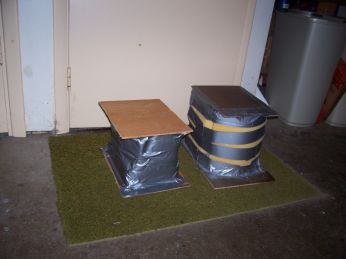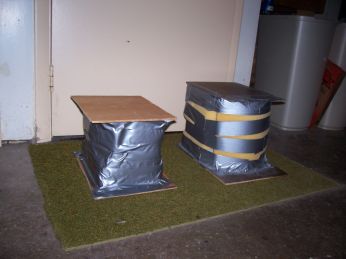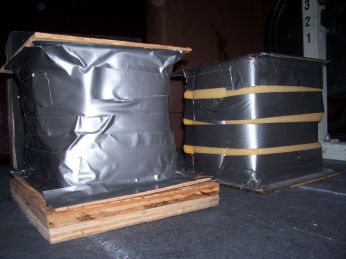


Fitness for One and All Home Page
Books and eBooks by the Director
Extra Low Foam Squat Box
A while back (October 2007 to be exact) I posted an article about building a foam squat box for depth checking. That message discussed how I made the box and why foam works better than a wooden box. That foam box has been working great for being sure I am hitting correct depth. See the following page for that article: Foam Squat Box.
In my last squat workout, I felt really weak in the hole. I have been doing what I call “Dead Stop Squats” as my main bottom end squat assistance workout, as discussed in my powerlifting book (pp. 144-5). But with having a problem in the hole in my last regular squat workout, it doesn’t appear like that exercise is working as well as I had hoped.
I think that stopping with the bar on the racks is just too different than having to stop the descent in mid-air like for regular squats. I’ve experienced the same problem with Box Squats. They seem to hurt not help my regular squat as sitting on a box is just too different. I thought of doing the “Low Squats” that I also discuss in my book (p. 144). Those worked well before, but they are only a partial movement and thus are best paired up with Partial Squats. Also again, my form there is to tap the safeties, which conceivably could help stop the descent.
As a result, I began racking my brain as to what would be a better squat assistance exercise for strengthen the bottom end. Then I thought about how well Platform (Deficit) Deadlifts (PDLs) are working as a bottom end assistance exercise for deadlifts. For those who don’t know, PDLs are performed by standing on a 2-3” thick platform. This in essence has you pulling the bar from lower than usual and lengthening the pull in general. With my last workout rotation, after doing the PDLs Week A, regular DLs just flew off the floor in Week B, and it felt like a short stroke to completion. For further details on PDLs, see my book (p.164).
In any case, I figured that since adding a couple of inches to the DL worked so well, then maybe the best squat assistance exercise would be to just do regular squats but to sink them a couple of inches lower than regular squats. This should then make just breaking parallel seem easy. But to ensure I am actually going a couple of inches lower, I needed another foam squat box, same as my previous one but a couple of inches shorter. Fortunately, I still had some scraps of foam left from when I built my first box. But I had to use a lot of duct tape to hold all of the pieces together. I am calling the new box my “extra low foam squat box” and thus this new assistance exercise “Extra Low Squats.”
After trying out the extra low box, it seemed to work even better than my first box. The first box was too firm, as it seemed like it helped a little in stopping me and lifting me back up if I sat down fully on it. But the new box, probably since it was made with less foam and just scraps of foam, is much less firm. It doesn’t hold me at all, so I figured it would be better to use it for regular squats as well. To do so, I figured I would place boards underneath the extra low box to raise it up when using it for regular squats. I experimented with different heights for the extra low foam box and thus different stacks of nailed together boards to put under it.
I first tried two boards and a piece of paneling, making for a difference of 1-3/4” from regular squats. But that wasn't enough of a difference. Then I cut some of the foam from the foam box to shorten it, making it 3" lower than my regular box. I used four boards underneath for regular squats. But when I tried it for the extra low squats, I had a very hard time getting that low and aggravated a previous adductor (inner thigh muscle) injury. I still thought extra low squats will be a good exercise to do, both for help on raw squats and to stretch out and strengthen my adductor.
As such, what I did was to remove one of the four boards and nailed it to the bottom of the extra low box, raising it ¾” of an inch. That should eliminate the undo stretching. As such, my extra low squats is 2-1/4” lower than regular squats, and I use three boards underneath for regular squats. That works out just right.
With the new box set for extra low squats being about two inches shorter than for regular squats (7.75” vs. 10”), it also works well in my power rack. The holes are 2” apart, so I set the safeties one hole lower than usual, and they’re at the correct height. I have the safeties set so they are just below where the bar is when I hit the box. That way, if the bar taps the safeties I know I am leaning too far forward, so the safeties serve as a form checker, along with of course being there for safety if I miss a rep.
Note that I am only 5’1”, so if you make such a box or boxes for yourself, you need to adjust for your height. But remember, it is only the length of the lower leg that matters. Mine is 18.5” measured from the bottom of my heel in stocking feet to the top of my knee with my leg bent. Add an inch to that for the heel on my squat shoes.
As for how much lower to go for extra low squats than for regular squats, probably 2-3" would be right for most people. But experiment with different heights to see what works best for you. And don't try going too low initially, or you could injure yourself. And note that just a half of an inch either way can make a big difference in the feel of the lift.
Pictures
Below are a couple of pics of both boxes side by side so you can see the size difference (click the pics for a larger image), then is a pic of the extra low box on boards for regular squats. Then are videos of my three work sets from my first workout using the extra low box. Compare this to the video on the above linked to page while using my regular squat box. But note, these pics and vids were of my first try, when the extra low box was only 1-3/4” lower than my regular box.
The pics below are of my final box and boards. The first pic has the extra low box with the one board on the bottom on the left and the three boards nailed together on the right. The second pic is the box on the boards as for regular squats.
By way of update, it is now February 2015, and I have been using this extra low foam box for about five years with the extra boards underneath for regular squats and without the boards for extra low squats, and it has been working out great. I know I am hitting the correct height on each and every rep, and despite the odd creation, the foam box itself is holding up just fine. So this foam box is a good idea, especially for anyone who trains alone like I do and thus doesn't have someone to tell you how deep you are going.
September 2017 Update
I said above that 1-3/4” didn't seem to be enough of a difference, so I redid it to 3” then to 2-1/4” Well, I probably had it right the first time. The 2-1/4” proved to be too much, as it was too much of a struggle and too tiring going that low. It also seemed to throw my form off to go that low.
I experienced the same thing with using a 3” (4 board) deficit for deadlifts. I had previously taken a board off, making it 2-1/4”, and that has been working better for deficit deadlifts. In fact, I began to do most of my deadlift assistance work with a 2-1/4” (3 board) deficit. That is probably why the bar seemed to come up from the floor rather easily at my most recent contest (see APF/ AAPF Ohio State Powerlifting Championships – 2017).
Since that idea worked so well for deadlifts, I figured a similar one would work strengthen the bottom end of squats, as I missed my third attempt in the hole at my most recent contest. I took the third board off of the second part of the foam box and nailed onto the main part, giving me an extra low depth of 1-1/2” below legal depth, while keeping the box the same height for regular squats. I will now use the extra low depth for most of my squat assistancework. Below are the same two pics as above with new setup. Click for a larger image.
Extra Low Foam Squat Box. Copyright © 2010-2017 By Gary F. Zeolla.
Powerlifting and Back Pain The first book is geared towards the beginner to
intermediate powerlifter. It presents sound training, competition, dietary, and
supplement advice to aid the reader in starting and progressing in the sport of
powerlifting. The second book details how I overcame years of crippling low back
and was able to return to the sport of powerlifting.
Starting and Progressing in Powerlifting: A Comprehensive Guide to the World's
Strongest Sport
Overcoming Back Pain: A Mind-body Solution (Second Edition) See also this series on
Amazon (#ad).
The above article was posted on this site on March 2. 2010.
It was last updated September 16, 2017.
![]() Powerlifting and Strength Training
Powerlifting and Strength Training
![]() Text
Search
Text
Search ![]() Alphabetical
List of Pages
Alphabetical
List of Pages ![]() Contact
Information
Contact
Information
![]() Fitness
for One and All Home Page
Fitness
for One and All Home Page
Books and eBooks by the Director